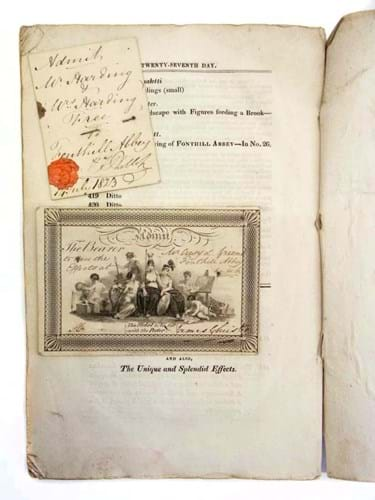
As an incomplete copy of the 1823 Fonthill Abbey sale catalogue, it was of moderate interest. More arresting were the two tickets of entry to the sale pinned to the back page, each personally inscribed and signed by James Christie II (1773-1831) and Harry Phillips (d.1840) - both great names in the history of British fine art auctioneering.
James Christie, who had assumed management of his father's auction house on his death in 1803, had been invited by William Beckford, deluged by debt after the collapse of the West Indian sugar market from which he enjoyed his fortune, to put Fonthill Abbey and its contents up for sale in 1822.
Previously closed to visitors, the chance to gawp at a fabled collection within its mock-medieval halls sparked the Fonthill Fever, which saw 72,000 copies of Christie's illustrated catalogue sold at a guinea apiece as an estimated 600 to 700 people a day visited in August and September 1822.
But, having whetted the nation's appetite for the mother of all country house auctions, Beckford found a buyer desperate to pay over the odds for the whole kit and caboodle and promptly cancelled the sale. It was thus that the vendor of the 'Beckford' sale of October 1823 was not William Beckford at all but John Farquhar, a Scottish gunpowder millionaire who had bought the abbey and much of its contents the previous year for £330,000.
And the auctioneer who conducted the sale was not James Christie II (who in 1823 had moved from Pall Mall to 8 King Street) but Harry Phillips, a shadowy figure who two decades previously had resigned as senior clerk to James Christie (1730-1803) after reportedly being refused a pay rise.
Since opening his own auction house in 1796, Phillips had snatched many prestigious sales away from his ex-employer, combining business acumen with a flair for showmanship.
New ways to win clients and promote his sales had included elaborate evening receptions before important auctions.
Nor was Phillips adverse to another practice familiar to 21st century sale goers - seasoning the contents of an estate sale with merchandise from other clients.
Famously, the Fonthill sale was the subject of William Hazlitt's scathing review of Beckford's taste in his Sketches of the Picture Galleries of England (1824), although he had been unaware that the sale had been padded with many lots inserted by Phillips, that had never passed Beckford's muster.
"I would not disgrace my house by Chinese furniture," he remarked later in life. "Horace Walpole would not have suffered it in his toyshop at Strawberry Hill."
As it was, Beckford, buying for his new home in Lansdown Crescent, Bath, and his son-in-law the Duke of Hamilton, were heavy purchasers at the Fonthill sale of 1823, often paying knock-down prices in a depressed market.
Plus ça change, plus c'est la même chose...




